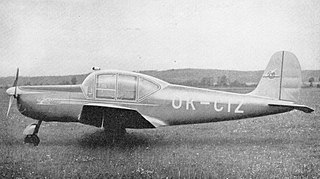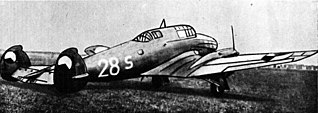Related Research Articles

The Miles M.14 Magister is a two-seat monoplane basic trainer aircraft designed and built by the British aircraft manufacturer Miles Aircraft. It was affectionately known as the Maggie. It was authorised to perform aerobatics.

The Ikarus Aero 2 was a piston-engined military trainer aircraft built in Yugoslavia in the years following World War II, although the design pre-dated the war.

The Aero 45 was a twin piston-engined civil utility aircraft produced in Czechoslovakia after World War II. Aero Vodochody produced the aircraft in 1947–1951, after which the Let Kunovice rolled out these planes until 1961. In 1958 the Ae-45S became the first Czechoslovak plane to cross the Atlantic Ocean. It was the first product of the nation's postwar aviation industry and proved a great success, with many of the 590 produced being exported.

The Aero A.101 was a biplane light bomber and reconnaissance aircraft built in Czechoslovakia during the 1930s.

The Aero A.304 was a Czechoslovakian bomber aircraft that first flew in 1937. It had originally been developed as an airliner, the A.204, but when Aero could not find buyers for the design, it was militarised and successfully marketed to the Czechoslovak Air Force.

The Aero A.300 was a Czechoslovak bomber aircraft that first flew in 1938 as a much refined development of the A.304. It was designed by Aero to meet a requirement for a bomber-reconnaissance aircraft for the Czechoslovak Air Force, the Aero A-304 transport/bomber formed the basis for its design. It was a four-seat aircraft powered by two Bristol Mercury IX radial engines. The A-300 was faster than any other Czechoslovak aircraft in the inventory except for the Avia B-35 fighter. Despite showing much promise, development and production of the aircraft was stopped by the German occupation of Czechoslovakia.

The Zlin Z-26 Trener was a tandem-seat basic training aircraft built by the Czechoslovakian company Moravan. A low-wing monoplane of largely wooden construction, it was developed into a series of all-metal trainers. Several were also produced in aerobatic variants, known as the Akrobat.

The RWD 9 was a Polish sports plane of 1934, constructed by the RWD team.

The Tupolev ANT-14 Pravda was a Soviet aircraft, which served as the flagship of the Soviet propaganda squadron. It has been credited as Russia's first all-metal aircraft, with a corrosion-resistant-steel structure.

The Alaparma Baldo was an unusual two-seat light monoplane produced in Italy shortly after World War II. Designed by Adriano Mantelli, it featured an egg-shaped fuselage with cabin doors that hinged upwards and to the back. The conventional tailplane with single fin and rudder was carried on twin booms, either side of a pusher engine installation. The undercarriage consisted of a single mainwheel under the fuselage pod, a small tailwheel not far behind it, and outrigger wheels on the wingtips.

The Mráz M-2 Skaut was a Czechoslovakian wooden two-seat, single engine, low wing sports aircraft of the late 1940s. In 2005 the design was revisited, resulting in the metal framed, modernised Scout which first flew in 2009 with plans for production and first deliveries in 2011.

The Boeing L-15 Scout or YL-15 was a small, piston engine liaison aircraft built by Boeing in small numbers after World War II. It was a short take-off and landing (STOL) aircraft powered by a 125 hp (93 kW) Lycoming engine. The L-15 intended by Boeing to expand its product line as World War II drew to a close, and Boeing's production of military aircraft declined. Boeing decided against marketing the L-15 as a general aviation aircraft, and the twelve produced went to the United States Army for testing, then were transferred to the United States Fish and Wildlife Service in Alaska for various duties.

The Mráz M-3 Bonzo was a light aircraft built in Czechoslovakia in 1948 as a further development in the family of light aircraft that had commenced with the M-1 Sokol.
The Handley Page H.P.46 was a two-seat, single-engined biplane built to an Air Ministry specification for a carrier-based torpedo bomber. With an advanced combination of high lift, slow flying controls it was beset by handling problems and made few flights.

The Avia B.158 was a prototype Czechoslovak twin-engined light bomber aircraft of the 1930s. Only a single example was built and it was abandoned, following the German occupation of Czechoslovakia in March 1939.

The Praga E-210 was a four-seat, twin-engined touring aircraft built in Czechoslovakia in the late 1930s. It had an unusual pusher configuration. Its tail unit and undercarriage were modified significantly before World War II and after the war a more powerful version designated E-211 was flown.

The Aero HC-2 Heli Baby is a two-seat general-purpose light utility helicopter, designed by engineer Jaroslav Šlechta, and produced by the Czechoslovak company Aero Vodochody in the 1950s. It has a three-blade main rotor, and a two-blade tail rotor. The helicopter has an entirely metal frame and cockpit, and windows made of Plexiglas. It was the first and the only Czechoslovak-designed helicopter to be produced.

The Beneš-Mráz Be-150 Beta-Junior was a light aerobatic trainer and racing aircraft, designed and built in Czechoslovakia in the late 1930s.

The Praga E-51 is a Czechoslovakian reconnaissance aircraft and light bomber built by Praga in the 1930s. Development was halted by the annexation of Czechoslovakia by Germany, after only one prototype had been built. The appearance of the construction is very reminiscent of the contemporary twin engined fighter, the Fokker G.I from Holland.

The Praga E-55 was a prototype Czechoslovakian multi-purpose single-engine light aircraft designed by ČKD-Praga and intended for the Czechoslovak Army. A single example was built, first flying in 1949, but the type was not selected for production, and the single example was used by an aeroclub before being withdrawn from use in 1953.
References
- 1 2 3 4 Marjánek 1980, p. 712.
- ↑ Simpson 1995, p. 156.
- 1 2 3 4 Marjánek 1980, p. 713.
- ↑ Marjánek 1980, pp. 713–714.
- ↑ Marjánek 1980, pp. 712–713.
- Marjánek, Pavel (1980). "Mongrafie: Aero Ae-50". Letectví + Kosmonautika (in Czech). Vol. 56, no. 18. pp. 712–714.
- Simpson, R. W. (1995). Airlife's General Aviation (Second ed.). Shrewsbury: Airlife Publishing Ltd. ISBN 1-85310-577-5.